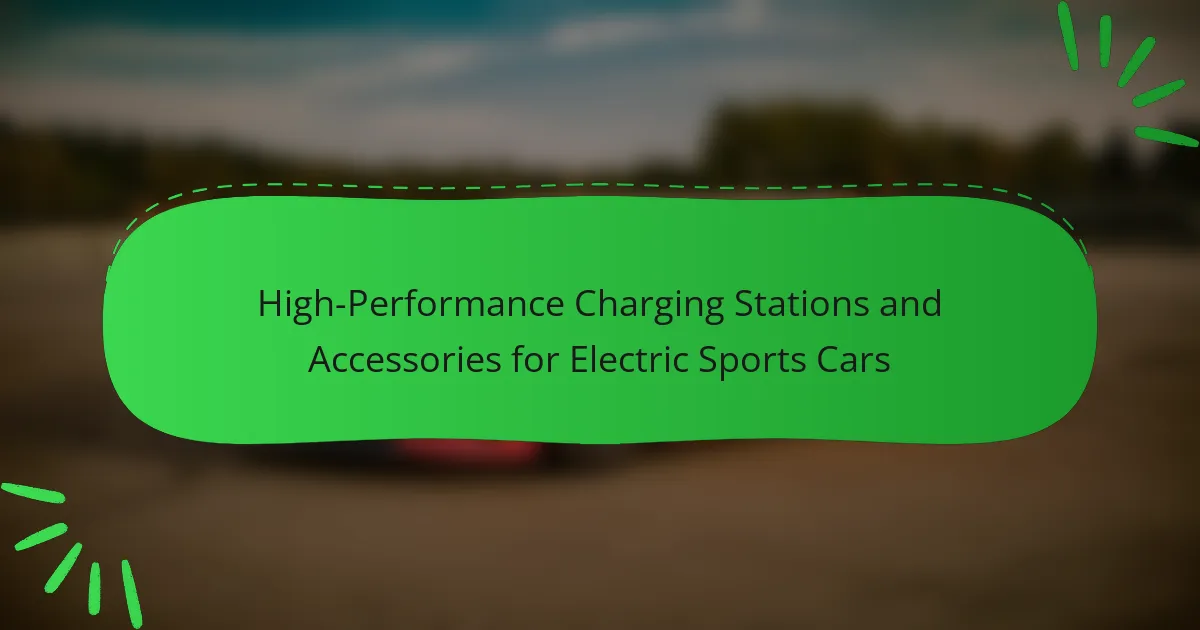High-performance charging stations for electric sports cars provide rapid charging, reducing downtime and enhancing convenience. These stations deliver power levels up to 350 kW, feature advanced cooling systems, and support multiple vehicle models. Accessories like smart charging cables and energy management systems improve functionality and user experience. However, challenges such as limited availability and installation costs may impact accessibility for users.
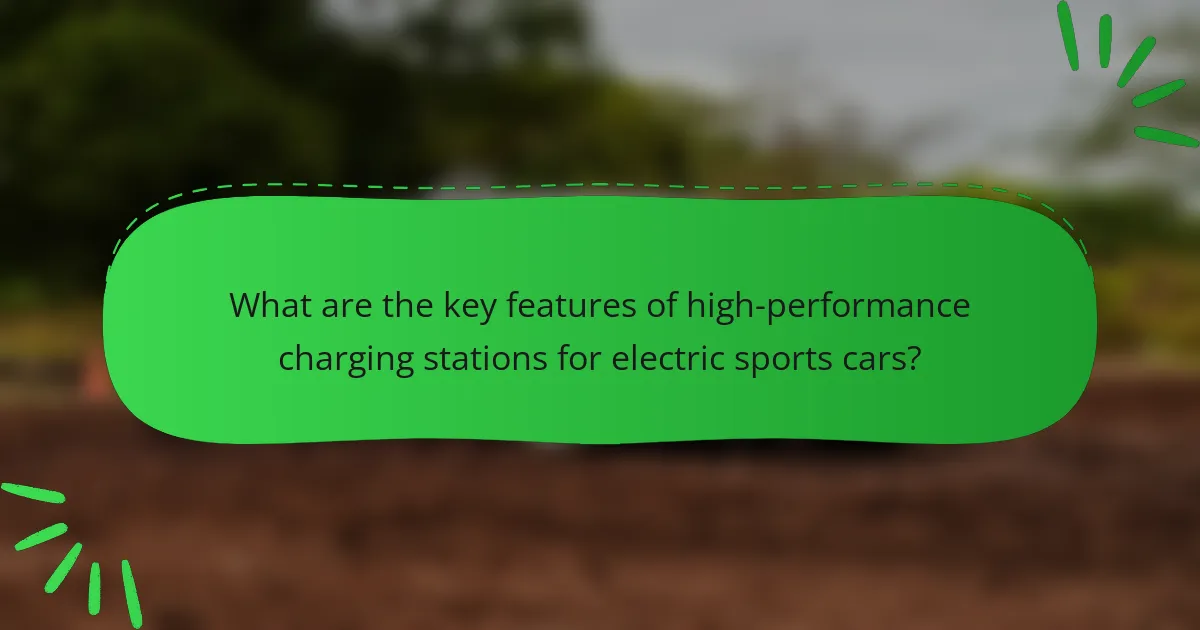
What are the key features of high-performance charging stations for electric sports cars?
High-performance charging stations for electric sports cars feature rapid charging capabilities, advanced cooling systems, and smart connectivity. These stations typically provide high power output, often exceeding 150 kW, allowing for quick recharges. They incorporate safety features, such as overcurrent protection, and often include user-friendly interfaces for easy operation. Additionally, many stations support multiple charging standards, ensuring compatibility with various electric sports car models.
How do charging speeds impact the performance of electric sports cars?
Charging speeds significantly enhance the performance of electric sports cars by reducing downtime and enabling quick energy replenishment. High-performance charging stations can deliver up to 350 kW, allowing vehicles to gain substantial range in mere minutes. Faster charging positively impacts driving dynamics, as drivers can maintain optimal energy levels during intense driving sessions. Moreover, advanced charging accessories can optimize battery management, ensuring longevity and efficiency. This synergy between charging speed and vehicle performance is crucial for maximizing the driving experience in electric sports cars.
What types of connectors are commonly used in high-performance charging stations?
Common types of connectors used in high-performance charging stations include CCS, CHAdeMO, and Tesla connectors. CCS (Combined Charging System) supports fast charging and is widely adopted in Europe and North America. CHAdeMO is popular for Japanese electric vehicles, while Tesla connectors are exclusive to Tesla vehicles. Each connector type supports varying power levels and charging speeds, enhancing the efficiency of electric sports cars.
How does power output affect charging efficiency?
Power output significantly influences charging efficiency, with higher outputs reducing charging time. High-performance charging stations for electric sports cars often provide outputs ranging from 150 kW to over 350 kW. This allows for rapid charging, enabling drivers to quickly resume their journeys. Increased power output also minimizes energy loss during the charging process, enhancing overall efficiency. Consequently, electric sports cars benefit from both faster charging times and improved energy utilization at high-performance stations.
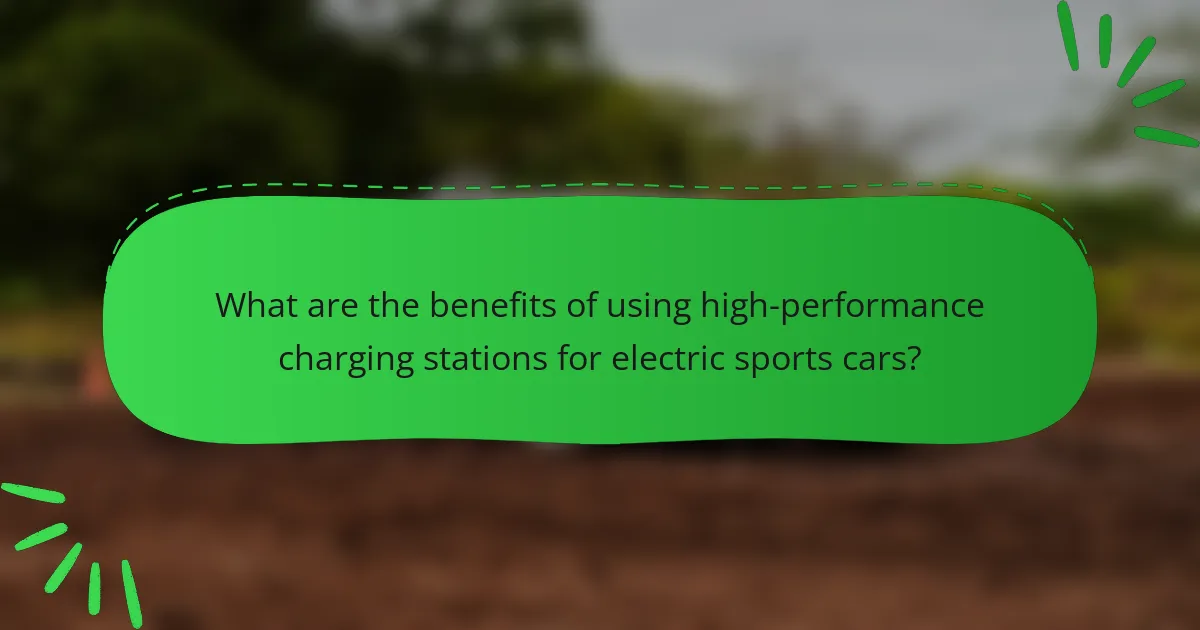
What are the benefits of using high-performance charging stations for electric sports cars?
High-performance charging stations for electric sports cars offer rapid charging, enhancing convenience and reducing downtime. These stations typically deliver power levels up to 350 kW, allowing for a full charge in under 30 minutes. Improved battery longevity is another benefit, as optimized charging reduces heat and wear. Additionally, many high-performance stations come equipped with advanced connectivity features, enabling users to monitor charging status remotely. Enhanced compatibility with various electric sports car models ensures broad usability, making these stations essential for performance-focused drivers.
How do these stations enhance the driving experience?
High-performance charging stations significantly enhance the driving experience of electric sports cars by providing rapid charging, convenience, and advanced features. These stations can charge vehicles to 80% in under 30 minutes, allowing drivers to spend less time waiting and more time enjoying the road.
Additionally, many stations offer real-time data on charging status and availability through mobile apps, enabling drivers to plan their journeys effectively. Enhanced connectivity features, such as Wi-Fi and entertainment options, further improve the overall experience.
The integration of high-performance charging stations with electric sports cars ensures that drivers can maintain peak performance, with some models featuring charging systems optimized for high power output. This synergy not only supports longer trips but also maximizes the vehicle’s capabilities, reinforcing the appeal of electric sports cars.
What cost savings can be realized with high-performance charging?
High-performance charging stations can lead to significant cost savings for electric sports car owners. These stations reduce charging time and increase efficiency, minimizing energy costs. For instance, a high-performance station can recharge a vehicle in under 30 minutes, compared to several hours with standard chargers. This efficiency translates into lower operational costs and increased vehicle utilization. Additionally, faster charging can enhance battery lifespan, reducing long-term replacement expenses. Overall, adopting high-performance charging technology can lead to substantial financial benefits for users.
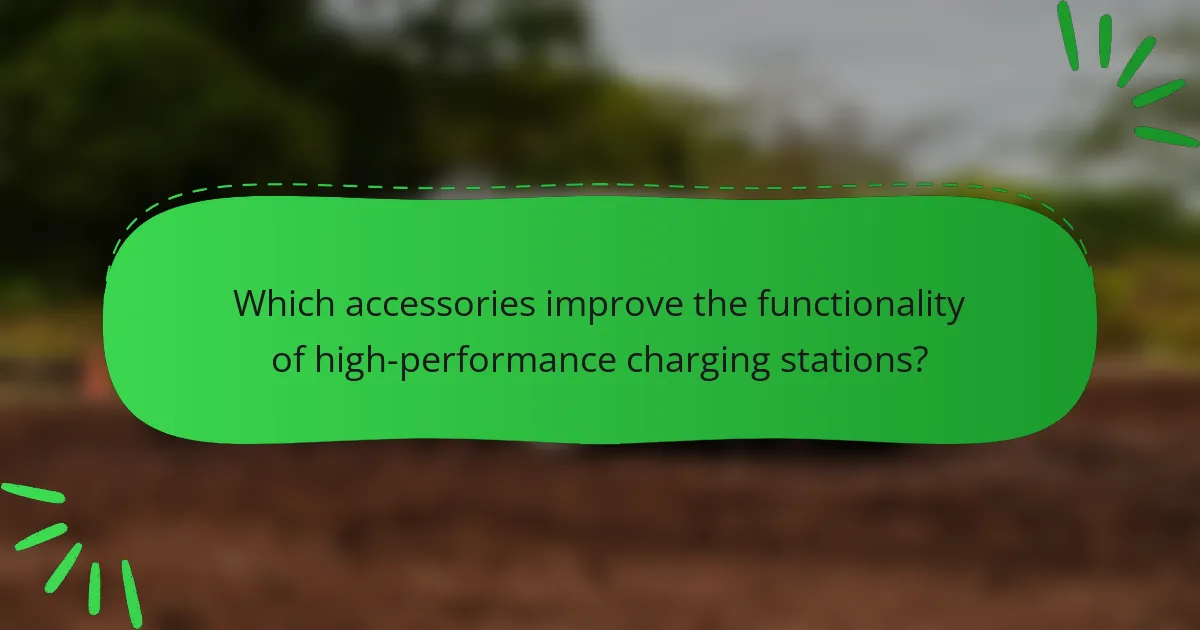
Which accessories improve the functionality of high-performance charging stations?
High-performance charging stations benefit from specific accessories that enhance their functionality. Key accessories include smart charging cables, adapters for various vehicle types, and energy management systems. These tools improve efficiency, compatibility, and user experience. Additionally, features like integrated displays and mobile app connectivity provide real-time monitoring and control, making charging more convenient and effective.
What role do smart charging apps play in managing charging sessions?
Smart charging apps optimize charging sessions by enabling users to schedule, monitor, and control their electric sports car charging. These applications enhance efficiency and convenience by providing real-time data on charging station availability and energy costs. Users can set preferences for charging speeds and notifications, ensuring optimal battery health and performance. Additionally, some apps integrate with smart home systems, allowing for seamless energy management. This unique attribute of connectivity further elevates the user experience, making smart charging apps essential for high-performance electric sports car owners.
How can portable chargers complement high-performance stations?
Portable chargers enhance high-performance charging stations by providing flexibility and convenience for electric sports car owners. They allow for charging on-the-go, ensuring that drivers can maintain optimal battery levels during long trips or races.
These portable chargers often feature high-capacity batteries, typically around 20,000 mAh, enabling multiple charges for electric vehicles. Their compact design allows easy storage in sports cars, making them practical accessories.
Moreover, portable chargers can complement charging stations by acting as backup power sources during peak times or when charging stations are unavailable. This dual functionality supports the unique needs of high-performance electric sports cars, ensuring drivers remain powered throughout their journeys.

What challenges do users face with high-performance charging stations?
Users face several challenges with high-performance charging stations, including limited availability, high installation costs, and compatibility issues. Accessibility can be a significant barrier, as not all locations support these advanced chargers.
Additionally, the charging speed may vary, causing inconvenience during long trips. Users may also encounter maintenance issues, leading to downtime. The need for specialized connectors can further complicate the charging experience, especially for electric sports cars.
How do availability and accessibility of charging stations impact electric sports car owners?
The availability and accessibility of charging stations significantly influence electric sports car owners’ experiences. Access to high-performance charging stations ensures faster charging times, enhancing convenience for users.
Limited charging infrastructure can deter potential buyers due to concerns about range anxiety. Studies show that regions with a higher density of charging stations report increased electric vehicle ownership.
Moreover, strategic placement of charging stations near popular driving routes can boost the appeal of electric sports cars. As a result, manufacturers are increasingly focusing on partnerships to expand charging networks, thus addressing consumer needs effectively.
What are common technical issues encountered with high-performance charging stations?
Common technical issues with high-performance charging stations include connectivity problems, software glitches, hardware malfunctions, and compatibility issues with different electric sports car models. These issues can lead to slower charging times or complete charging failures. Regular updates and maintenance can mitigate some of these challenges.

What unique attributes distinguish specific high-performance charging stations?
High-performance charging stations for electric sports cars are distinguished by their rapid charging capabilities, advanced cooling systems, and compatibility with multiple vehicle models. These stations often feature unique attributes such as ultra-fast DC charging, which can deliver up to 350 kW, significantly reducing charging time. Additionally, many high-performance stations incorporate smart technology for optimized energy management and user interfaces that enhance the charging experience. Rare attributes may include solar integration for sustainable energy sourcing, providing an eco-friendly solution for high-performance electric vehicles.
How do regional regulations influence the design of charging stations?
Regional regulations significantly shape the design of charging stations for electric sports cars. These regulations dictate standards for safety, accessibility, and environmental impact, influencing station layout and technology integration. For instance, some regions mandate fast charging capabilities, while others focus on renewable energy sources. Compliance with local regulations ensures stations meet legal requirements and consumer expectations, enhancing user experience. Additionally, unique attributes like aesthetic design may be prioritized in affluent areas, reflecting local culture and values.
What innovative technologies are emerging in the high-performance charging market?
Innovative technologies in the high-performance charging market include ultra-fast charging systems, wireless charging solutions, and advanced battery management systems. These developments enhance charging speed, efficiency, and user convenience.
Ultra-fast charging stations can deliver up to 350 kW, significantly reducing charging time for electric sports cars. Wireless charging technology uses inductive charging pads, allowing users to charge without plugging in. Advanced battery management systems optimize battery performance, extending lifespan and improving safety.
Emerging technologies like vehicle-to-grid (V2G) systems enable electric sports cars to return energy to the grid, providing additional value to owners. These innovations collectively shape the future of high-performance charging, enhancing the overall electric vehicle experience.
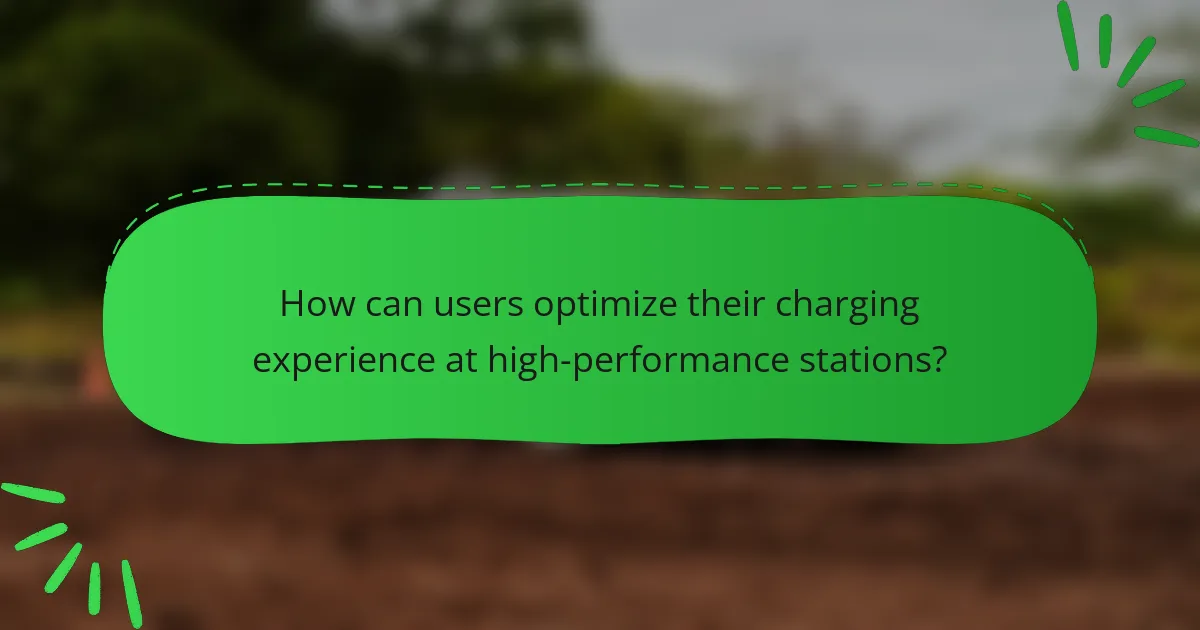
How can users optimize their charging experience at high-performance stations?
Users can optimize their charging experience at high-performance stations by selecting compatible chargers, monitoring charging speeds, and utilizing smart charging features.
Choosing a charger that matches the electric sports car’s specifications ensures efficient energy transfer. For example, chargers with higher power ratings can significantly reduce charging time. Monitoring real-time charging speeds via an app helps users adjust their plans accordingly. Smart charging features, such as scheduling, allow users to take advantage of off-peak energy rates, enhancing cost-effectiveness.
Utilizing these strategies maximizes both performance and convenience at high-performance charging stations.
What best practices should users follow for efficient charging?
To efficiently charge electric sports cars, users should follow these best practices. First, use high-performance charging stations that offer fast charging capabilities to minimize downtime. Second, ensure the vehicle’s battery management system is updated for optimal charging efficiency. Third, avoid charging to 100% regularly; instead, aim for 20% to 80% for battery longevity. Fourth, utilize smart charging accessories that can schedule charging during off-peak hours to save on energy costs. Lastly, monitor charging temperature to prevent overheating, which can affect battery performance.
What common mistakes should be avoided when using high-performance charging stations?
Avoiding common mistakes when using high-performance charging stations can enhance efficiency and safety. First, ensure compatibility between the charging station and your electric sports car. Secondly, avoid using damaged cables or connectors, as they can cause malfunctions. Third, do not exceed the recommended charging duration to prevent battery degradation. Lastly, always follow manufacturer guidelines for optimal performance and safety.
